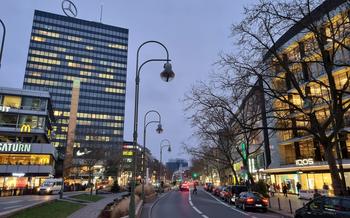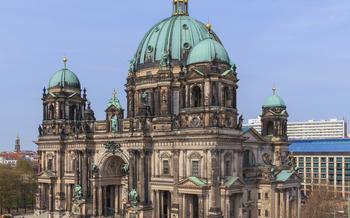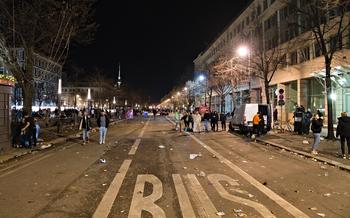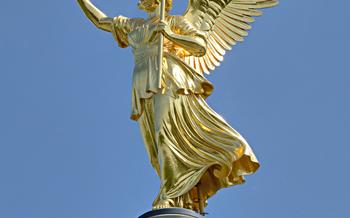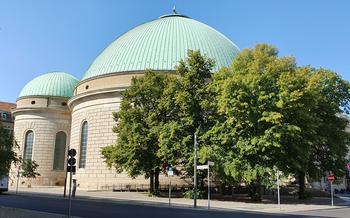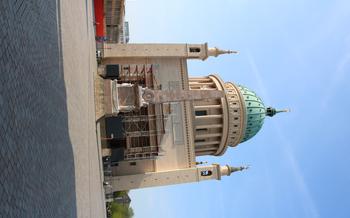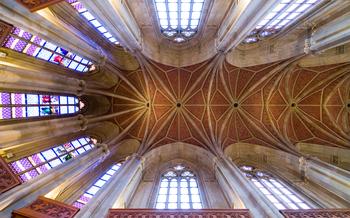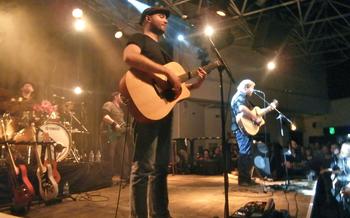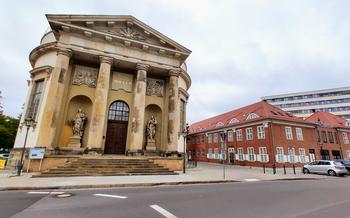
Gendarmenmarkt
- Gendarmenmarkt: A Cultural Corner in Berlin's Heart
- French Cathedral (Französischer Dom):
- German Cathedral (Deutscher Dom): A Witness to History
- Concert Hall (Konzerthaus Berlin): A Haven for Classical Music Aficionados
- Schauspielhaus Berlin: A Theatre of Prestige
- Hotel de Rome: A Luxurious Stay
- The Huguenot Museum: A Glimpse into History
- Restaurants and Cafes: Culinary Delights
- Shopping: Retail Therapy in the Heart of Berlin
- Walking Tours: Explore the Neighborhood
- Christmas Market: Festive Traditions
- Public Transport: Easy Accessibility
- Gendarmenmarkt's Past and Present
- Safety and Security
- Insider Tip: Hidden Café with a View
Gendarmenmarkt: A Cultural Corner in Berlin's Heart
Nestled in the heart of Berlin's bustling Mitte district, Gendarmenmarkt stands as a testament to the city's rich history, cultural heritage, and architectural splendor. This iconic square, once a parade ground for the city's gendarmes, has transformed into a vibrant hub of cultural and artistic expression. With its stunning ensemble of historical buildings, world-renowned concert halls, and prestigious theaters, Gendarmenmarkt offers visitors a unique blend of history, culture, and entertainment.
Location and Accessibility:
Gendarmenmarkt is conveniently situated in the heart of Berlin's city center, making it easily accessible by public transport. The Französische Straße U-Bahn (subway) station is just a short walk away, connecting visitors to the city's extensive public transport network.
Architectural Landmarks:
The square is adorned with a trio of magnificent buildings that define its architectural character. The French and German Cathedrals, with their distinctive domes, stand as symbols of religious harmony and architectural prowess. The Konzerthaus Berlin, with its elegant neoclassical façade, is a renowned concert hall that has hosted some of the world's most acclaimed musicians and orchestras.
Cultural Institutions and Events:
Gendarmenmarkt is a vibrant hub for cultural activities and events throughout the year. The Konzerthaus Berlin hosts a diverse program of classical music concerts, opera performances, and recitals, featuring renowned soloists and orchestras. The Schauspielhaus Berlin, a prestigious theater, stages a variety of plays, musicals, and contemporary dance performances, showcasing the talents of renowned actors and directors. The square also hosts regular cultural events, including art exhibitions, film screenings, and literary readings, contributing to its vibrant cultural atmosphere.
French Cathedral (Französischer Dom):
The French Cathedral, or Französischer Dom, stands as a remarkable landmark in the Gendarmenmarkt, a testament to the rich cultural heritage of Berlin. Its history dates back to the late 17th century when French Huguenots, fleeing religious persecution in France, found refuge in Berlin. They were granted the right to build their own church, and the French Cathedral was constructed between 1701 and 170
Designed by Huguenot architect Abraham Quesnay, the cathedral showcases a blend of Baroque and Classical architectural styles. Its striking façade features a triangular pediment adorned with intricate carvings and sculptures depicting biblical scenes. The interior of the cathedral exudes a sense of tranquility, with its high vaulted ceilings, elegant columns, and beautiful stained glass windows.
Beyond its religious significance, the French Cathedral has played a pivotal role in the cultural life of Berlin. It has served as a venue for concerts, exhibitions, and other events, hosting renowned artists and performers throughout the centuries. Today, the cathedral continues to be a vibrant center of cultural activity, housing the Huguenot Museum, which offers insights into the history and traditions of the Huguenot community in Berlin.
One of the highlights of the French Cathedral is its magnificent dome, which offers breathtaking panoramic views of the Gendarmenmarkt and the surrounding cityscape. Visitors can climb the 250 steps to the top of the dome to enjoy unparalleled vistas of Berlin's landmarks, including the Reichstag, the Brandenburg Gate, and the Berlin Cathedral.
German Cathedral (Deutscher Dom): A Witness to History
The German Cathedral, also known as Berliner Dom, stands as a testament to the grandeur of the Hohenzollern dynasty and the architectural prowess of the 19th century. Its intricate neo-Renaissance style, characterized by symmetrical facades, ornate carvings, and a striking dome, is a visual feast for any visitor. The cathedral's construction began in 1894 and spanned nearly two decades, reflecting the meticulous attention to detail and the ambition of its architects.
Originally intended to serve as the dynastic mausoleum for the Hohenzollerns, the German Cathedral has witnessed significant historical events throughout its existence. It has hosted the weddings and burials of Prussian royalty, served as a symbol of German unity during the Empire, and endured the tumultuous periods of war and political upheaval. Today, it remains an active place of worship and a popular tourist attraction, offering visitors a glimpse into the opulent past of Berlin.
Inside the cathedral, visitors are greeted by a breathtaking array of artworks, sculptures, and stained-glass windows. The intricate mosaics adorning the interior tell stories from the Bible and German history, while the grand organ with over 7000 pipes reverberates with majestic sounds during concerts and services. Notable features include the Hohenzollern Crypt, where members of the dynasty are laid to rest, and the Imperial Staircase, a testament to the grandeur of the Prussian monarchy.
Concert Hall (Konzerthaus Berlin): A Haven for Classical Music Aficionados
In the heart of Gendarmenmarkt, the Konzerthaus Berlin stands as a testament to the city's rich musical heritage. This architectural masterpiece, designed by renowned architect Karl Friedrich Schinkel, was completed in 1821 and has since become one of the world's most prestigious concert halls.
The Konzerthaus Berlin boasts an impressive neoclassical façade, adorned with intricate carvings and sculptures. Its elegant interior features a horseshoe-shaped auditorium with three tiers of balconies, offering exceptional acoustics and unobstructed views of the stage.
Over the years, the Konzerthaus Berlin has hosted a galaxy of renowned conductors and orchestras, including Wilhelm Furtwängler, Herbert von Karajan, and the Berliner Philharmoniker. Its stage has witnessed countless memorable performances, from classical masterpieces to contemporary compositions.
The hall's reputation for musical excellence has attracted a discerning audience, including royalty, dignitaries, and music lovers from around the world. It has become a cultural landmark, synonymous with the highest standards of classical music performance.
In addition to its concert offerings, the Konzerthaus Berlin also hosts a range of educational programs, masterclasses, and workshops, fostering a vibrant musical community and nurturing the next generation of musicians.
Whether you're a seasoned classical music enthusiast or simply seeking an unforgettable cultural experience, a visit to the Konzerthaus Berlin is a must. Immerse yourself in the exquisite acoustics, marvel at the architectural beauty, and let the music transport you to a realm of pure auditory delight.
Schauspielhaus Berlin: A Theatre of Prestige
Nestled amidst the cultural treasures of Gendarmenmarkt, the Schauspielhaus Berlin stands as a beacon of theatrical excellence. Its rich history dates back to the 18th century, when it was established as a playhouse for the royal court. Over the years, the theatre has undergone several transformations, each adding to its grandeur and prestige.
The Schauspielhaus Berlin boasts an impressive architectural design, showcasing a blend of Neoclassical and Art Nouveau elements. Its elegant façade adorned with intricate carvings and sculptures, hints at the theatrical magic within. Inside, the theatre features a grand auditorium with plush red velvet seats, intricate balconies, and a majestic proscenium arch.
Throughout its illustrious history, the Schauspielhaus Berlin has hosted a diverse range of productions, from classic dramas to contemporary masterpieces. Renowned actors, directors, and playwrights have graced its stage, leaving an indelible mark on the theatre's legacy. Among them are theatrical legends such as Bertolt Brecht, Gustaf Gründgens, and Helene Weigel, whose performances captivated audiences and shaped the course of German theatre.
In recent years, the Schauspielhaus Berlin has undergone extensive renovations, restoring it to its former glory while incorporating modern amenities. Today, it continues to be a vibrant hub for the performing arts, hosting a variety of productions, including thought-provoking dramas, experimental plays, and captivating musicals.
With its rich history, stunning architecture, and world-class performances, the Schauspielhaus Berlin is a must-visit destination for theatre enthusiasts and culture seekers alike. Whether you're a seasoned theatregoer or a first-time visitor, the Schauspielhaus Berlin promises an unforgettable theatrical experience.
Practical Tips:
- Check the theatre's website or box office for the latest performance schedule and ticket information.
- Advance booking is recommended, especially for popular productions.
- Dress code is typically smart casual.
- The theatre offers guided tours providing a glimpse behind the scenes and sharing fascinating stories about its history and productions.
- The Schauspielhaus Berlin is wheelchair accessible and offers assisted listening devices for hearing-impaired patrons.
Hotel de Rome: A Luxurious Stay
In the heart of Gendarmenmarkt, elegance and history intertwine at the Hotel de Rome, a former bank building transformed into a luxurious haven. Originally constructed in the 1860s, this architectural masterpiece boasts a neo-Renaissance facade that exudes grandeur. Step inside to be greeted by a breathtaking atrium, where marble floors, intricate moldings, and a soaring glass dome create an awe-inspiring first impression.
Each of the hotel's 146 rooms and suites is meticulously designed to blend modern amenities with classic charm. High ceilings, plush fabrics, and opulent furnishings create an atmosphere of refined comfort. Relax in the marble bathrooms, featuring deep soaking tubs and walk-in showers, and enjoy the convenience of in-room amenities such as flat-screen TVs, minibars, and high-speed Wi-Fi.
Indulge in culinary delights at the hotel's signature restaurant, La Banca, which occupies the former banking hall. Savor innovative Italian cuisine amidst the stunning backdrop of the atrium, where original vault doors serve as a reminder of the building's financial past. For a light bite or a refreshing drink, the hotel's bar, Le Bar, offers a cozy ambiance and an extensive menu of cocktails, wines, and tapas.
Ascend to the rooftop terrace for breathtaking panoramic views of Gendarmenmarkt and the surrounding cityscape. Sip a cocktail at the rooftop bar while admiring the iconic landmarks and the vibrant atmosphere below. The Hotel de Rome epitomizes luxury and sophistication, offering guests an unforgettable stay in the heart of Berlin's cultural epicenter.
The Huguenot Museum: A Glimpse into History
Situated within the French Cathedral, the Huguenot Museum offers a captivating journey into the history and legacy of the Huguenots, a French Protestant community that sought refuge in Berlin during the 17th century. Through a diverse collection of exhibits, the museum sheds light on their culture, traditions, and the significant contributions they made to the city's development. Visitors can explore the Huguenots' religious beliefs, their craftsmanship, and their role in shaping Berlin's vibrant tapestry. Guided tours and educational programs provide deeper insights into their fascinating story, making the Huguenot Museum a must-visit for anyone interested in Berlin's rich cultural heritage.
Restaurants and Cafes: Culinary Delights
Gendarmenmarkt offers a diverse array of dining options, catering to various tastes and budgets. From traditional German cuisine to international flavors, there's something for every palate.
For a taste of authentic German cuisine, visit the Hofbräuhaus Berlin, a traditional Bavarian restaurant known for its hearty dishes and lively atmosphere. Indulge in classics like schnitzel, roasted pork knuckles, and pretzels paired with a refreshing stein of beer.
If you're seeking a more contemporary dining experience, head to Restaurant 100, housed within the historic Hotel de Rome. This Michelin-starred restaurant offers a creative fusion of French and German cuisine, showcasing seasonal ingredients and elegant presentations.
For those craving international flavors, try the Italian restaurant Amici miei, where you can savor authentic pasta dishes, pizzas, and antipasti. Or, transport yourself to Asia at the sophisticated Umami, which serves modern Japanese cuisine with a focus on fresh seafood and innovative sushi creations.
During the warmer months, take advantage of the outdoor seating options at many restaurants and cafes in Gendarmenmarkt. Enjoy a leisurely meal al fresco while soaking in the vibrant atmosphere of the square.
For a delightful treat, stop by the Lindt Chocolate Shop, a haven for chocolate lovers. Indulge in a variety of delectable chocolates, from classic truffles to creative seasonal creations.
Shopping: Retail Therapy in the Heart of Berlin
The Gendarmenmarkt area offers a delightful shopping experience, catering to diverse tastes and budgets. Whether you seek unique souvenirs, local products, or international designer brands, you'll find a treasure trove of options in the vicinity.
Stroll along the charming streets surrounding the square and discover a variety of boutiques and shops showcasing local crafts, handmade souvenirs, and specialty items. Take home a piece of Berlin's artistic heritage or find the perfect gift for loved ones back home.
For a more comprehensive shopping experience, head to the nearby Galeries Lafayette, a renowned department store offering a wide range of fashion, accessories, and homeware from international brands. The mall also features a gourmet food hall, where you can indulge in culinary delights from around the world.
For those seeking luxury goods, the Friedrichstrasse shopping district, located just a short walk from Gendarmenmarkt, boasts flagship stores of prestigious brands such as Louis Vuitton, Gucci, and Prada. Here, you can indulge in some high-end retail therapy and treat yourself to a truly special souvenir.
Tips for Shopaholics:
-
Unique Souvenirs: Look for shops specializing in Berlin-themed souvenirs, such as postcards, magnets, and miniature replicas of iconic landmarks.
-
Local Delicacies: Don't miss the opportunity to sample local delicacies like currywurst and artisanal chocolates, available at specialty food shops.
-
Tax-Free Shopping: Take advantage of tax-free shopping if you're a non-EU resident. Remember to bring your passport and ask for a tax refund form at participating stores.
-
Shopping Hours: Most shops in Berlin are open from 10 am to 7 pm, with extended hours on Thursdays and Fridays. Department stores typically have longer operating hours.
-
Markets: Explore the flea markets and street markets held in the area for unique finds and vintage treasures.
Walking Tours: Explore the Neighborhood
Discover the captivating history and hidden gems of Gendarmenmarkt on foot with guided or self-guided walking tours. Explore the square's rich past, from its origins as a horse market to its transformation into a cultural hub. Learn about the architectural wonders, such as the Französischer Dom and the Deutscher Dom, and their significance in Berlin's cityscape.
Guided walking tours provide an immersive experience, led by knowledgeable historians or local experts. They delve into the stories behind the monuments, sharing anecdotes and insights that bring the square to life. These tours often include visits to lesser-known corners and hidden courtyards, offering a glimpse into the neighborhood's hidden treasures.
For a more independent exploration, embark on a self-guided walking tour. Create your own route using a map or download a mobile app that offers audio guides and GPS navigation. Explore at your own pace, stopping to admire the architecture, soak in the atmosphere, and capture the perfect photo.
Don't miss the opportunity to discover the fascinating tales and verborgen corners of Gendarmenmarkt on foot. Whether you choose a guided tour or navigate independently, a walking tour is an excellent way to immerse yourself in the cultural and historical richness of this vibrant square.
Christmas Market: Festive Traditions
The Gendarmenmarkt transforms into a magical winter wonderland during the annual Christmas market, held from late November to late December. The square is adorned with twinkling lights, festive decorations, and rows of traditional wooden stalls. The air is filled with the scent of mulled wine, roasted chestnuts, and gingerbread. Visitors can browse a variety of handmade crafts, ornaments, and gift ideas, perfect for finding unique souvenirs or presents for loved ones.
Traditional food and beverage specialties are a highlight of the market, with vendors offering everything from hearty sausages and potato pancakes to sweet pastries and hot chocolate. Sample local delicacies like Glühwein (mulled wine), Feuerzangenbowle (flaming rum punch), and Lebkuchen (gingerbread cookies) while soaking up the festive atmosphere.
The Christmas market at Gendarmenmarkt is a must-visit for anyone seeking a truly magical and authentic German Christmas experience. With its charming ambiance, festive traditions, and delicious treats, it is a perfect place to celebrate the holiday season and create lasting memories.
Public Transport: Easy Accessibility
Gendarmenmarkt's central location makes it effortlessly accessible via public transportation. The U-Bahn (subway) lines U2 and U6 have a stop at Hausvogteiplatz, conveniently situated just a short stroll from the square. Alternatively, the S-Bahn (city train) lines S1, S2, and S25 stop at Brandenburger Tor station, a 5-minute walk away.
Several bus routes also service the area, with stops located nearby. Buses M48 and 200 stop at Hausvogteiplatz, while buses 100 and 248 stop at Französische Straße. Detailed information on fares, tickets, and schedules can be obtained from the Berliner Verkehrsbetriebe (BVG), Berlin's public transport authority.
Gendarmenmarkt is well-equipped to cater to individuals with disabilities. Both U-Bahn and S-Bahn stations feature elevators and step-free access, ensuring seamless mobility for all visitors. Additionally, most buses in Berlin are equipped with ramps for wheelchair users.
For those who prefer a more leisurely approach, renting a bicycle is an excellent option. Numerous bike rental shops are located throughout Berlin, and cycling lanes are prevalent in the city, making it easy and enjoyable to explore the area on two wheels.
Gendarmenmarkt's Past and Present
Gendarmenmarkt has undergone a rich transformation throughout history. Initially developed as a marketplace for the city's growing population in the 17th century, it was transformed into a parade ground for the elite Gendarmes cavalry regiment in the 18th century, giving the square its name. The 19th century brought significant architectural additions, including the iconic cathedrals and concert hall.
During World War II, the square suffered severe damage, with the cathedrals and concert hall sustaining significant structural and interior damage. The post-war period saw a meticulous reconstruction effort, restoring the square to its former glory. Today, Gendarmenmarkt stands as a testament to Berlin's resilience and its commitment to preserving its architectural heritage.
Ongoing restoration and preservation efforts ensure that Gendarmenmarkt retains its grandeur and charm. The square's cultural significance is further enhanced by plans for future development and projects, including exhibitions, events, and public art installations. These initiatives aim to revitalize the square while respecting its historical integrity and cultural legacy.
Gendarmenmarkt's evolution reflects Berlin's own transformation over the centuries, from a bustling marketplace to a cultural hub and a symbol of resilience. Its past and present intertwine, creating a vibrant and dynamic space that continues to captivate visitors and locals alike.
Safety and Security
Gendarmenmarkt is generally a safe area for visitors, with a low crime rate. However, as with any major city, it's essential to be aware of your surroundings and take necessary precautions. Here are some safety tips to keep in mind:
- Be cautious of pickpockets, especially in crowded areas.
- Avoid walking alone at night, particularly in poorly lit areas.
- Keep your valuables secure and out of sight.
- Be wary of individuals offering unsolicited services or goods.
- If you witness or experience any suspicious activity, report it to the police immediately.
The Gendarmenmarkt area is well-patrolled by the police, and there are emergency services readily available. If you need assistance, don't hesitate to approach a police officer or seek help from a nearby establishment. By following these safety tips and exercising common sense, you can ensure a safe and enjoyable visit to Gendarmenmarkt.
Insider Tip: Hidden Café with a View
Amidst the grandeur of Gendarmenmarkt, there lies a hidden gem that offers a unique perspective of the square: a charming café tucked away on a quiet side street. With its intimate ambiance and panoramic windows, this café provides a tranquil haven for those seeking a respite from the bustling city.
As you step inside, you'll be greeted by the warm aroma of freshly brewed coffee and the gentle hum of conversation. The café's interior is tastefully decorated with vintage furniture, soft lighting, and potted plants, creating a cozy and inviting atmosphere.
But the true highlight of this café is its stunning view of Gendarmenmarkt. From your seat, you can admire the intricate details of the Französischer Dom and Deutscher Dom, as well as the majestic Konzerthaus Berlin. The square's vibrant energy and cultural significance come alive as you sip your coffee and soak in the breathtaking panorama.
Whether you're a history buff seeking inspiration, a traveler looking for a peaceful retreat, or simply someone who appreciates a good cup of coffee with a view, this hidden café is a must-visit. Take a break from the tourist crowds, find a cozy spot by the window, and let the beauty of Gendarmenmarkt unfold before your eyes.
Personal Anecdote:
On a crisp autumn morning, I stumbled upon this hidden café while exploring the backstreets of Gendarmenmarkt. Intrigued by its unassuming façade, I stepped inside and was immediately captivated by the warm and inviting atmosphere. As I ordered a steaming cup of cappuccino, I took a seat by the window and marveled at the stunning view of the square.
The sunlight danced across the golden domes of the cathedrals, casting a warm glow on the surrounding buildings. People bustled about, creating a vibrant tapestry of life against the backdrop of history. I sipped my coffee slowly, savoring the moment and feeling a sense of tranquility wash over me.
As I left the café, I couldn't help but smile at the serendipitous discovery I had made. This hidden gem had offered me a unique perspective on Gendarmenmarkt, reminding me of the beauty and charm that can be found off the beaten path.
